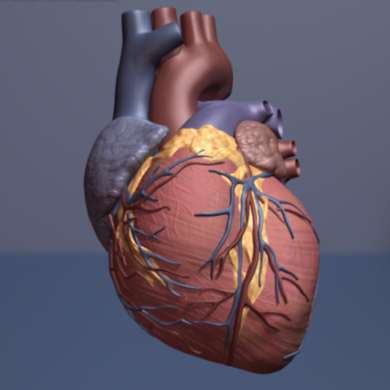How genes and environment interact to raise risk of congenital heart defects

Infants of mothers with diabetes have a three- to five-fold increased risk of congenital heart defects. Such developmental defects are likely caused by a combination of genetic and environmental factors. However, the molecular mechanisms by which maternal diabetes disrupts normal heart development in genetically susceptible individuals remain unclear.
In a new study, researchers led by Vidu Garg, MD, director of the Center for Cardiovascular Research in The Research Institute at Nationwide Children's and the Nationwide Foundation Endowed Chair in Cardiovascular Research, describe a gene-environment interaction resulting in congenital heart defects in both mouse and fly model systems.
"We had previously shown an interaction between two genes, Endothelial Nitric Oxide Synthase and Notch1, would result in more severe types of congenital heart defects in animal models," says Dr. Garg, who is also professor of pediatrics and molecular genetics at The Ohio State University.
"Diabetes is known to be associated with decreased nitric oxide levels in blood vessels. We hypothesized that maternal diabetes, in combination with a mutation in Notch1, would result in a higher risk of congenital heart disease."
In the new study, a collaboration with Zhe Han, PhD, at Children's National in Washington, D. C., the researchers show that maternal hyperglycemia reduces the chromatin accessibility of the Endothelial Nitric Oxide Synthase gene, resulting in decreased nitric oxide production. This loss of nitric oxide is associated with an increase in expression of Jarid2, a known repressor of the Notch1 gene. This directly inhibited Notch1 expression to levels below a critical threshold necessary for normal heart development.
This study lends support to a gene-environment interaction model where maternal hyperglycemia raises the risk of congenital heart defects by reducing Notch1 expression. The results reveal the epigenetic machinery by which maternal hyperglycemia disrupts the Nitric Oxide and Notch1 signaling pathways, leading to congenital heart defects.
"Only a subset of infants that are exposed to hyperglycemia develop a congenital heart defect, which supports the idea that there are genetically susceptible individuals," says Dr. Garg, who is also a pediatric cardiologist in The Heart Center at Nationwide Children's Hospital. "That raises the question: Can we identify those genetically susceptible infants and their mothers?"
Another question Dr. Garg is pursuing concerns the relationship between changes in maternal glucose level and changes in gene expression level.
"Is this a true dose-response curve? Do subtle elevations in blood glucose level during early pregnancy, when the heart is developing, increase the risk of a congenital heart defect?" asks Dr. Garg. "If so, can we identify expectant mothers who may be at risk for having a child with congenital heart defects even with modest elevations in blood glucose, as they may need closer monitoring of blood glucose levels during early pregnancy?"
The answers to these questions will have to come further down the road, says Dr. Garg. It may be some time before this knowledge can be used clinically, but this initial study provides important evidence that the risk of maternal diabetes-associated congenital heart defects can be influenced by genetic susceptibilities.
More information: Madhumita Basu et al, Epigenetic mechanisms underlying maternal diabetes-associated risk of congenital heart disease, JCI Insight (2017). DOI: 10.1172/jci.insight.95085

















